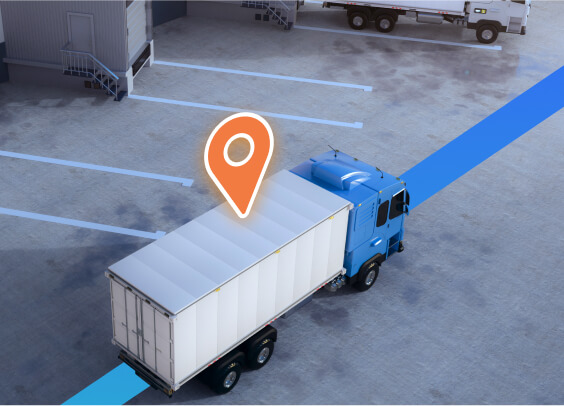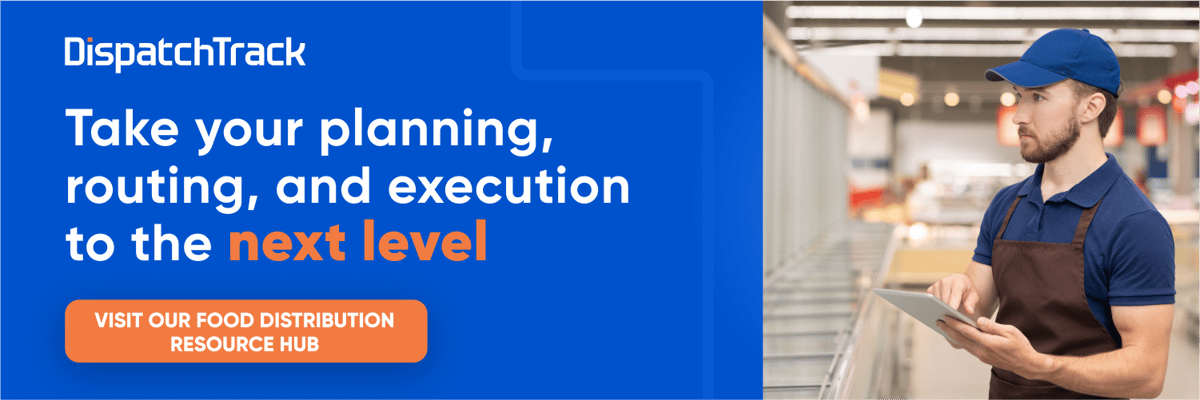Fleet management is all about making sure you have the right assets—in the right condition—to ensure successful last mile deliveries. When it comes to food distribution, this can be particularly challenging. Maximizing delivery capacity and tracking deliveries that are underway have historically been pain points for businesses in this industry, and there’s been a dearth of effective solutions that can solve these challenges in a practical way. 
That said, smarter fleet management is something that businesses can achieve with the right approach. When it comes to keeping your top customers happy (e.g. by delivering in their preferred time window), a lot has to go right. You need to get the right goods from the right distribution center to the right hub or crossdock, onto the right truck and route, and you need to make sure you’re able to deliver all of your orders on time by routing carefully and efficiently.
While you’re doing that, you need total visibility into your fleet from every angle. What’s your delivery capacity on any given truck or route? Which drivers are available which days? What happens if you switch a customer from one route to another? Can you actually take on new business in a particular area with your current fleet makeup?
When you can answer those questions more easily, you can achieve smarter fleet management and ultimately reduce costs and improve the service you offer to your customers across your entire fleet operations.
What Is Fleet Management?
Let’s step back for a second. What exactly do we mean by fleet management? At a high level, it’s anything to do with the management and use of your assets—i.e. reefers, vans, other trucks, you name it. This can include maintaining and tracking your assets as well as leveraging them for your delivery and fulfillment workflows.
Both sides of the coin are important. Tracking the usage of the assets within your fleet helps you prevent truck breakdowns by ensuring timely maintenance and upkeep, and simply keeping tabs on the locations of assets at all times is a crucial bulwark against theft and misuse.

At the same time, the value of your fleet is in its ability to help you meet demand with successful deliveries. This means getting the most out of your fleet capacity by strategically planning routes in such a way as to ensure that the right goods are loaded on the right assets at the right time.
More than that, you want to be able to stay flexible when customer needs change or when you take on new customers. This means that visibility into your capacity and capacity utilization are crucial. Unfortunately, this level of visibility can be difficult to achieve in some circumstances. When you don’t have the right tools for the job, you wind up doing things the way they’ve always been done because you can’t predict the impact of any proposed planning changes.
How Does It Impact Food Distributors?
Fleet management has a huge impact on food distributors’ ability to meet customer demand and grow their businesses. When you have visibility into your fleet capacity and can match the right assets to the right routes and deliveries, you can get more out of the resources you already have.
By the same token, when you’re able to strategically plan your last mile distribution efforts—with an emphasis on predicting costs and meeting delivery windows—you can grow your fleet with confidence. Rather than acquiring additional assets because you’re not sure how else to meet demand, you can match your fleet size to your current and projected customer base and demand profiles. This puts you in the driver seat when it comes to your business trajectory and helps you ensure lower fleet management costs.
The question is, how do you achieve the kind of fleet management capabilities we’re talking about?
Best Practices for Smarter Fleet Management in Food Distribution
If you’re trying to achieve more efficient and optimized fleet management, there are a few key tactics and best practices that you can rely on:
Strategic Planning
Route planning has historically been one of the most challenging processes that food distributors have to deal with. Every week will bring a mix of new and recurring orders, and it’s critical to balance the flexibility to take on new orders with the stability that your recurring customers demand. In other words, your fleet can’t run entirely new routes every week—but they can’t run the same routes either.
This is where a strong strategic planning process comes into play. By taking all of your distribution routes and optimizing them by frequency and days of the week, you can create the foundational plan you need to get the most out of your fleet. When you have an optimized plan that’s built for flexible reroutes and directly integrated with your daily routing process, you can ensure that you’re positioned to utilize your assets efficiently each day of the week no matter what orders get thrown your way.
SaaS Technology
Simply put, relying on on-premise technology deployments for fleet management is becoming more and more of a liability. Fleet management tools that offer support for their on-premise options are decreasing in number, while many of the solutions that distributors have historically relied on are forcing transitions to cloud solutions—often with much more limited functionality.
Transitioning to new technology can often have serious change management implications. But when it comes to true SaaS technology, the temporary disruption is usually worth it. For fleet management solutions in particular, upgrading to SaaS means effectively future proofing your operations.
Rather than worrying about keeping your software up to date across branches and making sure each solution plays nicely with the ones around it, you can let the software provider ensure that you’re running updated software with accurate and timeline data flows across your entire technology stack. This is a huge piece of the puzzle when it comes to enabling real fleet visibility.
End-to-End Visibility
Speaking of visibility: effective fleet management depends on having visibility into your fleet capacity, your asset locations, your delivery statuses, and more.
But what does that visibility really mean?
- Visibility across roles and functions: It’s not enough for your dispatchers to be able to see truck locations. Sales personnel should be able to access order statuses and ETAs for their orders through their own app. Customer support should have fleet data at their fingertips for resolving issues, etc.
- Visibility in context: Just knowing the GPS coordinates of a given asset doesn’t give you the visibility you need when deliveries are underway. Make sure you have a way to visualize not just locations but statuses and live ETA projections.
- Predictive visibility: What would happen if you added a new stop to a given route? What about a new route from a new DC? What if you onboarded a new customer? Real fleet visibility means being able to predict the answers to these questions without pulling your hair out from wrestling with spreadsheets.
What-If Scenarios
One of the keys to the kind of predictive visibility we saw at work above is to run what-if scenarios to test out potential changes on your routes and plans. These are essential test environments in which you can simulate what would happen if you made certain adjustments to a given plan.
These have high technological requirements in a way—you more or less need SaaS technology and AI-powered routing to make them practicable. But they can be invaluable for utilizing your fleet in the smartest and most cost-effective way possible.
Fleet management is always going to present potential challenges for food distributors. At the same time, it has the potential to become a real strength and operational pillar that ensures flexibility and stability across the last mile. How do you get to that point in your fleet operations? It starts with the right fleet management technology stack.